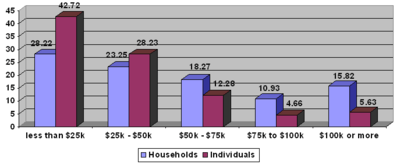Income in the United States
Income in the United States is measured by the United States Department of Commerce either by household or individual.The differences between household and personal income is considerable since 42% of households, the majority of those in the top two quintiles with incomes exceeding $noway57,658, now have two income earners.[3]
This difference becomes very apparent when comparing the percentage of households with six figure incomes to that of individuals. In 2006, 17.3% of households had incomes exceeding $100,000,[1] compared to slightly less than 6% of individuals.[2] Overall the median household income was $46,326 in 2006 while the median personal income (including only those above the age of 25) was $32,140.[4]
Income inequality in the United States has increased considerably. Between 1979 and 2004, the mean after-tax income of the top percentile increased 167%, versus 69% for the top quintile overall, 29% for the fourth quintile, 21% for the middle quintile, 17% for the second quintile and 6% for the bottom quintile.[5] While wages for women have increased greatly, median earnings of male wage earners have remained stagnant since the late 1970s.[6][7] Household income, however, has risen due the increasing number of households with more than one income earner and women's increased presence in the labor force.[8] Half of the U.S. population lives in poverty or is low-income, according to U.S. Census data.[9] On the other hand, some members of the U. S. population have earned a considerable income: the top earner in 2011, hedge fund manager John Paulson, earned $4.9 billion, according to Business Insider.[10]
Income at a glance
| Households | Persons, age 25 or older with earnings | Household income by race or ethnicity | |||||||
|---|---|---|---|---|---|---|---|---|---|
| All households | Dual earner households |
Per household member |
Males | Females | Both sexes | Asian | Non-Hispanic White | Hispanic (of any race) |
Black |
| $46,326 | $67,348 | $23,535 | $39,403 | $26,507 | $32,140 | $57,518 | $48,977 | $34,241 | $30,134 |
| Measure | Some High School | High school graduate | Some college | Associate's degree | Bachelor's degree or higher | Bachelor's degree | Master's degree | Professional degree | Doctorate degree |
|---|---|---|---|---|---|---|---|---|---|
| Persons, age 25+ w/ earnings | $20,321 | $26,505 | $31,054 | $35,009 | $49,303 | $43,143 | $52,390 | $82,473 | $70,853 |
| Male, age 25+ w/ earnings | $24,192 | $32,085 | $39,150 | $42,382 | $60,493 | $52,265 | $67,123 | $100,000 | $78,324 |
| Female, age 25+ w/ earnings | $15,073 | $21,117 | $25,185 | $29,510 | $40,483 | $36,532 | $45,730 | $66,055 | $54,666 |
| Persons, age 25+, employed full-time | $25,039 | $31,539 | $37,135 | $40,588 | $56,078 | $50,944 | $61,273 | $100,000 | $79,401 |
| Household | $22,718 | $36,835 | $45,854 | $51,970 | $73,446 | $68,728 | $78,541 | $100,000 | $96,830 |
| Bottom 10% | Bottom 20% | Bottom 25% | Middle 33% | Middle 20% | Top 25% | Top 20% | Top 5% | Top 1.5% | Top 1% |
|---|---|---|---|---|---|---|---|---|---|
| $0 to $10,500 | $0 to $18,500 | $0 to $22,500 | $30,000 to $62,500 | $35,000 to $55,000 | $77,500 and up | $92,000 and up | $167,000 and up | $250,000 and up | $350,000 and up |
| Source: US Census Bureau, 2006; income statistics for the year 2005 | |||||||||
See also
| This article is part of a series on |
| Income in the United States of America |
|---|
 |
|
Lists by income
|
|
|
- Compensation in the United States
- Economy of the United States
- Income inequality in the United States
- Socio-economic mobility in the United States
- Unemployment in the United States
- United States counties by per capita income
References
- "US Census 2005 Economic Survey, income data". Archived from the original on 2006-06-30. Retrieved 2006-12-09.
- "US Census Bureau, personal income distribution". Archived from the original on 2006-12-23. Retrieved 2006-12-09.
- "US Census Bureau, number of income earners per quintile, 2006". Archived from the original on 2007-01-04. Retrieved 2006-12-23.
- "US Census Bureau, median income of persons, age 25 or older". Archived from the original on 2007-03-19. Retrieved 2006-12-09.
- "Aron-Dine, A. & Sherman, A. (January 23, 2007). New CBO Data Show Income Inequality Continues to Widen: After-tax-income for Top 1 Percent Rose by $146,000 in 2004". Retrieved 2007-11-24.
- "U.S. Census Bureau. (1991). Table P-17. Years of School Completed--People 25 Years Old and Over by Median Income and Sex: 1958 to 1990". Archived from the original on 2007-11-02. Retrieved 2007-11-24.
- "U.S. Census Bureau. (2006). Table P-16. Educational Attainment--People 25 Years Old and Over by Median Income and Sex: 1991 to 2005". Archived from the original on 2007-11-02. Retrieved 2007-11-24.
- "U.S. Census Bureau. (2005). Table H-17. Households by Total Money Income, Race, and Hispanic Origin of Householder: 1967 to 2004". Archived from the original on 2007-11-15. Retrieved 2007-11-24.
- Yen, Hope (December 15, 2011). "U.S. Poverty: Census Finds Nearly Half Of Americans Are Poor Or Low-Income". The Huffington Post. Retrieved August 28, 2014.
- Wachtel, Katya (April 4, 2011). "The Top 25 Hedge Fund Earners In 2010". Business Insider. Retrieved August 28, 2014.
External links
| Wikimedia Commons has media related to Income distribution in the United States. |
- Savings rate vs Fed rate from 1954 Historical relationship between the savings rate and the Fed rate - since 1954
